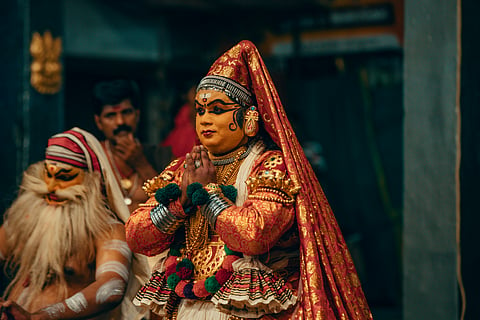

KOCHI: As part of its 21st anniversary celebrations, Edappally Kathakali Aswadaka Sadas, a society affiliated to the Kerala Sangeetha Nataka Akademi, will be organising ‘Kathakali Mahotsav 2024’ at Changampuzha Park from January 21 to 24.
Former Kalamandalam vice-chancellor Dr K G Paulose will inaugurate the event at 4 pm. K B Rajanandan, dean of Kerala Kalamandalam Kalpitha Sarvakalashala, will speak on the topic ‘Kottayam Kadhakal: Bakavadham’. At 5pm, the play ‘Bakavadham’ will be staged. Over 100 artists are expected to participate in the fest.
Sadas president Kesavan Nambisan says that in recent years, kathakali has garnered international acclaim, transcending cultural boundaries.
“Its intricate and visually stunning performances have attracted a diverse audience, fostering a global appreciation for this ancient art form. As perceptions broaden, kathakali is
increasingly seen not just as a cultural relic but as a dynamic and living art,” says Nambisan.
Established in 2003 at Changampuzha Park by the then Kochi Mayor and GCDA chairman Adv K Balachandran, the Sadas works for the development of traditional and classical art forms of the country. It has over 2,000 members. The main aim of Sadas is to bring the art form to a wider audience and attract more youths.
Earlier, kathakali was performed exclusively by male artists. They even portrayed female characters, says Sadas secretary N Suresh.
“However, contemporary perspectives have challenged these gender norms, leading to the inclusion of female performers in the kathakali domain. This transformation has not only expanded the talent pool but has also brought a fresh perspective to the portrayal of characters,” says Suresh.
The advent of technology and social media has also provided kathakali with a new platform for expression. Performances are now accessible to a global audience through online platforms, enabling a broader spectrum of people to experience and appreciate this ancient art form.
This shift in accessibility has been crucial in altering perceptions, making kathakali more visible and appreciable on a global scale.
When asked about Sadas’ initiatives to preserve the art form, Kesavan says, “In the face of modernisation, there has been a renewed emphasis on preserving and promoting traditional art forms. We are actively working to ensure that the essence of kathakali is not lost. For this, the Sadas conducts seminars, lecture classes and demonstrations. The commitment to preservation has contributed to a nuanced understanding and increased appreciation for the art form,” says Kesavan.
From its sacred origins to a globally celebrated dance-drama, kathakali has evolved while retaining its cultural roots. As audiences continue to embrace the dynamic nature of this ancient art, kathakali stands as a testament to the enduring power of tradition in an ever-changing world.